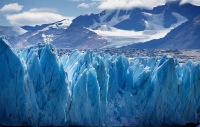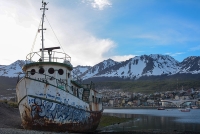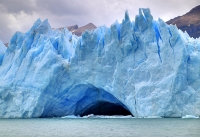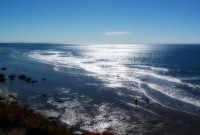Southern Argentina Travel Guide
The southern region of Argentina is a fascinating mix of desert, ice-capped mountains, vast plains, sandy beaches and majestic glaciers. South of the Rio Colorado is the captivating Patagonia region, an area of diverse landscapes largely protected by a dozen national parks and reserves. Temperatures in the region can be extreme, from mild to well below zero and most visitors wisely choose to travel to Patagonia in summer. Patagonia is far from an icy wasteland, however. Bursting with wildlife, the area is also covered with large tracts of arable land (producing large amounts of fruit and vegetables), and is home to the country's biggest oil and coal reserves.
The coastline in the south has the warmest water in the country and a favoured destination is Las Grutas, a tourist-oriented beach resort on the Blue Gulf in the Rio Negro province. The area takes its name from the many caves dotted about the coastline, and provides visitors with an opportunity to sunbathe on the sheltered beaches, or enjoy plenty of watersports. The southern coastline is also incredibly popular due to the large amounts of marine life that can be found here, from southern right whales to elephant seals, sea lions, and penguins, as well as an astounding array of birdlife.
Continuing further south, one hits the world's southern-most city, Ushuaia, situated on the Tierra del Fuego archipelago. This island territory (partly shared with Chile) is a favourite starting point for tours to Antarctica, but also offers plenty of activities and attractions for visitors, including trekking in the Andes in the western part of the archipelago, spectacular kayaking, some of the world's best brown trout fishing, and Argentina's only coastal national park. The southern region of Argentina is every bit as fascinating as the north and certainly has a lot to offer the intrepid traveller.
Things to do in Southern Argentina
The diverse terrain and striking landscapes of Southern Argentina attract many visitors seeking adventure and natural beauty. Travellers can explore the turquoise lakes of Patagonia's Lake District, and visit Argentina's chocolate capital Bariloche on the shores of Lago Nahuel Huapi. With skiing in the winter and a fine summer selection of water sports, camping, fishing and hiking, boredom is simply not an option.
The wild and beautiful desolation of Patagonia is not to be missed. On the Atlantic coast, visitors can admire the dramatic cliffs along the beaches of Las Grutas, and observe penguins, elephant seals, rheas, sea lions and endangered southern right whales in Reserva Faunística Península Valdes: one of South America's finest wildlife reserves and a UNESCO World Heritage site.
Majestic peaks and ice blue glaciers attract intrepid travellers to Western Patagonia, where the massive Glaciar Perito Moreno is the star of southern Parque Nacional Los Glaciares. Visitors to Argentina can head for the end of the earth, the southernmost tip of the Americas, as they cross the Magellan Strait to reach the Tierra del Fuego archipelago. Here, one can visit Ushuaia, the southernmost city in the world, and enjoy activities such as trout fishing, hiking, skiing and kayaking.

Patagonia
Adventurous travellers are drawn to the savage beauty and rich wildlife of Patagonia. This region of contrasts and extremes, stretching across Argentina and Chile, runs from the Colorado river, south of Buenos Aires, across to the southern tip of South America. Many people visit the famous wildlife reserve of Peninsula Valdesgo between July and April, where southern right whales, elephant seals and other rare marine mammals come to breed in their thousands. However, those going further south should visit only in the summer months if they wish to avoid temperatures that plummet to -13F (-25C).
In villages along the valley of the Río Chubut, visitors can explore the cultural legacy of the Welsh pioneers, and nearby at Punta Tombo lies the continent's largest penguin colony. Keen fly-fishermen come from around the world to test their skills in the region's rivers, the best known of which is the Río Gallegos. On the western fringe, along the Andes, visitors will find the most impressive of Patagonia's great lakes and national parks. The Parque Nacional Perito Moreno, home to the aquamarine gem of Lago Belgrano, has excellent trekking possibilities, as does the Parque Nacional Los Glaciares. Here visitors will find one of the world's natural wonders, the vast Perito Moreno Glacier, a great river of ice that breaks off into Lake Argentino.

Tierra del Fuego
This island territory at the tip of South America is shared by Chile and Argentina and is a place of staggering scenery. Though further south, the region doesn't reach the extreme temperatures of neighbouring Patagonia. The principal tourist destination is Ushuaia, a base for those visiting the dramatic Canal Beagle, trekking in the Parque Nacional Tierra del Fuego, and hiking the mountain ranges of southern Tierra del Fuego, with its magnificent scenery of lakes, snow-capped peaks and beechwood forests. Ushuaia is also the place to go if travellers want to visit Antarctica, since many ships depart from there to visit colonies of penguins, seals, sea lions and seabirds. The Les Eclaireurs Lighthouse is another drawcard, the area hosting a few small ski resorts, both downhill and cross-country. Visitors to the north of the island are usually keen fly-fishermen heading to the Río Grande, the world's best brown-trout river.

Perito Moreno Glacier
Situated in Los Glaciares National Park, a UNESCO World Heritage site, the breathtaking Perito Moreno Glacier is nearly 19 miles (30km) in length and spreads over an area of 97 square miles (250 sq km). The spectacular, blue-white ice formation is one of the only glaciers in the world that is growing, at a rate of seven feet (2m) per day. Enormous chunks of ice break off into the water with deafening crashes, creating icebergs and large waves. Perito Moreno is also world renowned for its unique rupturing process, where high pressure causes the dam of ice to crack and shatter, sending icebergs downstream. Ruptures like this occur on average every four to five years, although sometimes as often as every other year. The closest town to this natural wonder is El Calafate in Argentina's Santa Cruz Province, which is about two hours' drive away.

Las Grutas
One look at Las Grutas' beautiful beaches will show why it's become one of Argentina's most popular resorts. A dramatic landscape of cliffs and plateaus shield hidden strands and caves, giving way to gorgeous sea views. Each beach is numbered from zero to seven, with zero being the closest to downtown. The town boasts some of the warmest waters in the country and a rugged coastline ideal for paragliding, hiking and scuba diving. Las Grutas itself is small, with a few hotels, restaurants and spas, but it's great for exploring surrounding areas such as San Antonio Oeste, Puerto Madryn, Sierra Grande and Punta Tombo.
Argentina travel info
Electricity
Electrical current in Argentina is 220 volts, 50Hz. Most hotels and offices use the three-pin flat plug, though most older buildings use the two-pin round plug.
Language
Spanish is the official language of Argentina but English is generally understood in the tourist areas.
Money
The unit of currency is the Argentinean peso (ARS). Currency can be exchanged at banks and cambios (bureaux de change) but it is easier to use ATMs, available in most towns, which reflect the current exchange rate. Major credit and debit cards are generally accepted, and US dollars can be used in many tourist establishments.
Tipping
A 10 percent tip is expected at restaurants in Argentina. Porters expect some small change per bag.
Health
There are no major health risks in Argentina, except potential mosquito-borne viruses in the northern regions of the country. However, the risks are still fairly minimal and common safety precautions should provide enough protection. All eligible travellers should be up to date with their COVID-19 vaccines. Medical facilities are good in the major cities, though treatment is expensive and medical insurance is advised. Asthma, sinus and bronchial ailments can be aggravated by pollution in Buenos Aires. Those with specific conditions should bring a sufficient quantity of medical supplies and medication for the trip.
Safety
There is no specific threat to foreigners and travellers should not be discouraged from travelling throughout the country. However, it's best to be aware of bag-snatchers, pickpockets and con men, particularly in crowded areas in Buenos Aires, on public transport and in popular tourist haunts, such as San Telmo.
Local customs
Argentineans are warm and unreserved people. Both men and women greet each other by kissing on the cheek, and will often touch each other when speaking and maintain little physical distance between speakers. With its origins in the working-class neighbourhoods of Buenos Aires, tango lives on today as a cultural pillar of Argentinean society. Likewise, football in the country is almost like a religion and is a hugely significant part of its cultural identity.
Doing business
Business people dress well in Argentina and visitors are expected to wear a smart suit. Handshaking is normal. Argentineans are great conversationalists and are interested and knowledgeable about world events, politics and sports. Meetings usually begin with small talk and it's important to use titles when addressing people, the form being Senor (Mr), Senora (Mrs) and Senorita (Miss) followed by their surname.
Business culture in Argentina can be bureaucratic and, as with most South American countries, negotiation and decision making can take a long time and is best done face to face. Foreigners should make sure they see the right people, as only those in high positions are likely to be able to make a final decision. Business hours are 9am to 5pm in Buenos Aires, with an hour for lunch. Outside the capital, it is normal to take a siesta between 1pm and 4pm. Many business people are away on holiday during January and February.
Duty free
Travellers to Argentina over the age of 18 years can bring in the following items to the value of US$300 without incurring customs duty: two litres of alcohol, 400 cigarettes or 50 cigars, and 5kg of food items. Restrictions apply to fresh foodstuffs such as meat and dairy products. Prohibited items include explosives, flammable items, narcotics and pornographic material. Firearms and ammunition for sporting purposes are allowed if accompanied by a license or certificate.
Communications
The international access code for Argentina is +54. Mobile roaming charges can be expensive; prepaid local SIM cards are available for purchase on arrival and are a good alternative. Free WiFi is offered at most restaurants, cafes and hotels in tourist centred areas of the country.
Passport & Visa
Valid passports are required for travel to Argentina. Visas are not generally required for stays of less than three months, with the possibility of an extension of stay. It is recommended that all visitors have sufficient funds, as well as onward or return tickets and documents required for next destination. It is highly recommended that travellers' passports have at least six months' validity remaining after the intended date of departure from their travel destination. Immigration officials often apply different rules to those stated by travel agents and official sources.
Entry requirements
US nationals require a passport that is valid at the time of entry, but no visa is required for stays of up to 90 days.
UK nationals require a passport that is valid for the duration of their stay, but no visa is required for a stay of up to 90 days.
Canadians require a passport that is valid for the duration of their stay, but no visa is required for a stay of up to 90 days.
Australians require a passport that is valid for the duration of their stay, but no visa is required for a stay of up to 90 days.
South African nationals must hold a valid passport, but no visa is required for a maximum stay of up to 90 days.
Irish nationals require a valid passport, but no visa is required for a stay of up to 90 days.
New Zealand nationals require a valid passport, but no visa is required for stays of up to 90 days.
Useful contacts
National Secretariat of Tourism, Buenos Aires: +54 (0)11 4316 1600 or www.turismo.gov.ar
Emergencies: 101 (police), 107 (medical emergencies), 100 (fire), 911 for English language service in Buenos Aires only.Embassies / consulates in other countries
Embassy of Argentina, Washington DC, United States: +1 202 238 6400.
Embassy of Argentina, London, United Kingdom: +44 207 318 1300.
Embassy of Argentina, Ottawa, Canada: +1 613 236 2351.
Embassy of Argentina, Canberra, Australia: +61 2 6273 9111.
Embassy of Argentina, Pretoria, South Africa: +27 (0)12 430 3524/7.
Embassy of Argentina, Dublin, Ireland: +353 (0)1 269 1546.
Embassy of Argentina, Wellington, New Zealand: +64 (0)4 472 8330.
Embassies / consulates in Argentina
United States Embassy, Buenos Aires: +54 (0)11 5777 4533.
British Embassy, Buenos Aires: +54 (0)11 4808 2200.
Canadian Embassy, Buenos Aires: +54 (0)11 4808 1000.
Australian Embassy, Buenos Aires: +54 (0)11 4779 3500.
Embassy of South Africa, Buenos Aires: +54 (0)11 4317 2900.
Embassy of Ireland, Buenos Aires: +54 (0)11 5787 0801.
New Zealand Embassy, Buenos Aires: +54 11 5070 0700.



